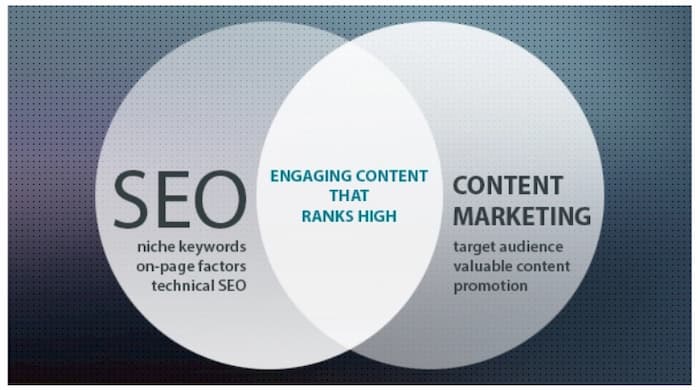
As an expert marketer, throughout my experience, I have observed that the connection between content marketing and SEO isn’t just complementary; it’s INSEPARABLE. When I first started optimizing websites, I quickly realized that without valuable and engaging content, even the best SEO techniques fall flat. After all, SEO drives traffic, sure, but content is what keeps people engaged, builds trust, and ultimately drives conversions.
Moreover, 90% of organizations use content marketing, and it generates 3 times more leads than traditional marketing while costing about 62% less. As algorithms evolve and audiences become more selective, I’ve learned that the secret to long-term growth lies in aligning SEO with a solid blogging strategy, one that’s designed for humans first, and search engines second. That’s exactly why I say that content marketing and SEO must go hand in hand.
Why Content Marketing and SEO Go Hand in Hand
Let’s get one thing clear: SEO and content marketing are not separate strategies. In fact, if I put it in simpler words, they’re two sides of the same coin.
When I create content, I don’t just toss in keywords and hope for the best. Instead, I dig deep into what my audience is searching for, what they need, and how they want to consume it. Then I craft content that answers those questions in a clear, helpful, and engaging way. If you ask me why I do this? Well, it’s because, according to HubSpot, publishing high-quality content is cited by 74% of marketers as the most effective SEO tactic.
Search engines reward this kind of user-centric content. Why? The reason is, it satisfies INTENT.
Here’s how the two work together:
- SEO gives direction to your content. It tells you what your audience is looking for.
- Content gives substance to your SEO. Without it, there’s nothing for Google to index.
- Together, they drive traffic that’s relevant and, more importantly, qualified.
In other words, when I develop a content marketing strategy for success, SEO has to be baked into every step and not just sprinkled on at the end.
Creating High-Quality Content for SEO
Every time I sit down to write, I ask myself two questions:
- What does my audience need to know?
- How can I say it better than anyone else?
That’s the heart of my SEO content creation approach. I never write just to fill space; I write to solve problems, answer questions, and deliver value.
To begin with, I start with keyword intent. Not just what people are searching for, but why are they searching for it. Then, I focus on how to structure the content with a purpose. For example, headings, bullet points, and short paragraphs make it easier to read and scan, so I make sure to add those in the right places.
Let’s have a detailed look at what I focus on:
- Depth and clarity: I ensure every piece I write answers a real question thoroughly.
- Internal linking: I guide readers to related articles and pages to improve SEO structure and session duration.
- Keyword integration: I never force it. Rather, I find natural ways to include primary and semantic keywords like content marketing, SEO content, and blogging strategy in headers and body copy.
- Multimedia and structure: Search engines appreciate well-structured content. So do humans.
Moreover, consistency plays a huge role. If I disappear from the blog for three months, so will a big chunk of my traffic. That’s why I treat my content calendar with the same seriousness as my business pipeline.
Furthermore, 70% of marketers report that SEO is more effective for generating sales than utilizing paid search (PPC), and I can assure you of this after spending almost a decade in the industry. In short, content isn’t just spreading information or entertaining users for the sake of it, but it drives measurable ROI with higher profit margins.
Content Distribution Strategies for Maximum SEO Impact

Creating great content is only half the battle. In reality, if you don’t distribute your content, it doesn’t exist.
This is exactly where content distribution comes into play. Over the years, I’ve learned that promoting content across multiple touchpoints, or as we now say, having an omnichannel approach, not only boosts reach but it compounds SEO authority.
Let’s look at how I approach it:
- Social media promotion: I repurpose my blog into posts, carousels, and infographics. This is because 89% of B2B marketers use organic social media to distribute content, and 84% use blogs.
- Email marketing: I send valuable pieces directly to my subscribers, often adding a personalized intro (helps in getting higher responses).
- Repurposing for reach: A blog becomes a podcast, a video, or even a guest column. All of it depends on which platform you are targeting.
- Backlink outreach: I pitch high-value content to relevant blogs and publications that are likely to link back. This increases visibility and signals to Google that your content is trustworthy and valuable.
Measuring Content Marketing ROI for SEO
If you’re not measuring results, you’re guessing. And frankly, guessing isn’t a sustainable strategy, at least it’s not relevant anymore.
I always look at:
- Organic traffic: Content marketing leaders experience 7.8x more site traffic than non-leaders.
- Keyword rankings: Is my content climbing in search results?
- Engagement: Are users staying, scrolling, and clicking?
- Conversions: Are they taking meaningful action, such as downloads or inquiries?
- Backlinks: Is the content gaining traction naturally?
Over time, I’ve found that the best content often doesn’t shine overnight. Instead, it performs consistently and improves month after month. Additionally, 35% of B2B marketers actually measure content marketing ROI, emphasizing the need for data-driven decisions.
The Future of Content Marketing and SEO
Looking forward, I believe that content and SEO will become even more intertwined. As a result, brands that prioritize human-first, value-driven content will outperform those who chase rankings alone.
This is what my prediction says,
- Topical authority will dominate like never before.
- SEO for multimedia will expand largely because of advancements.
- More personalized content will be posted as human-written content will hold more value as a differentiating point.
- Human+AI collaboration. Currently, 67% of small business owners and marketers use AI for content marketing or SEO, and they report a 70% increase in ROI
FAQs
How does content marketing affect SEO?
Content marketing fuels SEO by providing relevant, optimized material that search engines can index and rank. As a result, it increases visibility, drives engagement, and builds domain authority.
What types of content are best for SEO?
In my opinion, blog posts, how-to guides, pillar pages, and long-form case studies are among the best. That being said, it’s not just the format; it’s how well you address the reader’s intent.
How do I measure the success of my content marketing strategy?
Use KPIs like organic traffic, keyword rankings, user engagement, conversions, and backlinks. Over time, these indicators show how well your content is supporting your SEO efforts and brand growth.

